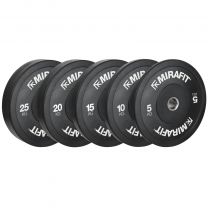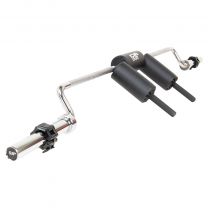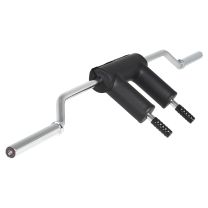Safety Squat Bar Benefits
Safety Squat Bar Benefits

Why Use a Safety Squat Bar?
1 - Not Restricted by Upper Body Mobility
A lot of people struggle with barbell back squats because they have poor upper body mobility. This is a common issue among many demographics, for instance, desk-based employees, who often struggle with mobility from prolonged sitting and a lack of movement.
The Safety Bar with the anterior handles, eliminates this issue; the handles allow you secure the bar without having to get your hands behind a traditional barbell.
2 - You Can Lift More Weight Than With a Kettlebell
A typical beginner’s squat variation is a goblet squat. One of the reasons for this is that it too accommodates for upper body mobility issues. However, there comes a point where your ability to hold the Kettlebell in your hands is the limiting factor in your leg gains. Enter the safety bar, which has the best of both worlds; it accommodates for upper body mobility but you can also load it up heavy!
3 - It Increases Comfort when Squatting
When people are new to back squatting, the barbell can be quite uncomfortable on their back and thus people tend to use a bar pad. This causes issues because the bar no longer sits in the correct position, over your centre of mass. This is not the case with the padding on the safety bar and thus provides a useful alternative for those new to squatting.
Will it Stop my Gains?

The Safety Squat Bar has been shown to have a similar loading pattern to the straight barbell and thus it simply comes down to preference. If you feel more confident with the Safety Squat Bar then it will only bring you more gains because you’re not limited by your mobility or confidence with the straight bar.
Top Three Safety Bar Exercises
1 - Safety Bar Back Squat

• Secure yourself under the safety bar and loosely grip the handles so that the handles can move freely as you squat.
• Take a deep breath and brace.
• Sit between your knees, until your hips are below your knees, with your hips and shoulders falling at the same rate.
• Stand up, with your hips and shoulders rising at the same rate, until you are back in your starting position.
Top Tip - Adjust your feet if you struggle for squatting depth.
If you struggle to get deep in a squat, try moving your feet slightly wider and facing slightly further out, this will open up your hips and give you more space to sit between your knees, whereas a very narrow stance with your feet facing straight on will be harder to get deep.
2 - Safety Bar Good Morning

• Secure the bar on your back, loosely holding the handles, just like the safety bar back squat.
• Stand with your feet around shoulder width.
• Then, with a slight bend in the knees, push your bum back to the wall behind you to hinge at the hips.
• Reverse the movement to complete the rep, taking a deep breath and brace in between each rep.
Top Tip - Keep your toes on the floor.
The cue to push your bum back to the wall behind you can sometimes lead to you putting too much weight into the heels and the toes coming off the floor, which is an unstable position.
To fix this, simply drive your big toe into the floor, while pushing your bum back, this will even out your foot pressure and make you more stable.
Safety Bar Split Squat

• Secure the bar on your shoulders while stood inside a Power Rack.
• Assume a stable split stance, with both feet facing forwards.
• Holding onto the bar, drop your back knee to the floor.
• Drive through your front leg to stand back up.
• Take a deep breath and brace in between each rep.
Top Tip - Keep your hips level.
With most single leg movements, stability at the hips is essential. Imagine you are balancing a pint on your head that you don’t want to fall off. This will keep your shoulders level and subsequently your hips too.
Next time you’re in your home gym, add these safety bar movements for a total lower body workout that’s not restricted by upper body mobility!
You can read our complete guide to squat racks here
Written by guest author Ewan Hammond.
For more content, follow us on Instagram, YouTube, TikTok, and on our official Mirafit Facebook page.
Enter your email to signup to our newsletter
Tags: Equipment > Bars & Weight Plates ; Exercise Type > Strength







